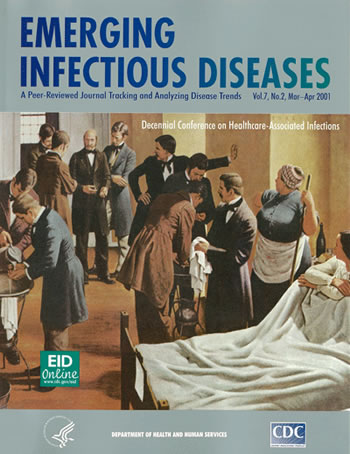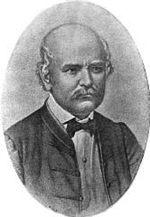Volume 7, Number 2—April 2001
About the Cover
Ignaz Philipp Semmelweis (1818-65)
Ignaz Philipp Semmelweis (1818-65) (Figure), a Hungarian obstetrician educated at the universities of Pest and Vienna, introduced antiseptic prophylaxis into medicine.
In the 1840s, puerperal or childbirth fever, a bacterial infection of the female genital tract after childbirth, was taking the lives of up to 30% of women who gave birth in hospitals. Women who gave birth at home remained relatively unaffected. As assistant professor on the maternity ward of the Vienna General Hospital, Semmelweis observed that women examined by student doctors who had not washed their hands after leaving the autopsy room had very high death rates. When a colleague who had received a scalpel cut died of infection, Semmelweis concluded that puerperal fever was septic and contagious. He ordered students to wash their hands with chlorinated lime before examining patients; as a result, the maternal death rate was reduced from 12% to 1% in 2 years. Nevertheless, Semmelweis encountered strong opposition from hospital officials and left Vienna in 1850 for the University of Pest.
As a professor of obstetrics at the University of Pest Hospital, he enforced antiseptic practices and reduced the death rate from puerperal fever to 0.85%. However, Semmelweis findings and publications were resisted by hospital and medical authorities in Hungary and abroad. After a breakdown, he entered a mental hospital in Vienna, where he died of an infection contracted during an operation he had performed.
Bibliography
- Information and photo from: funkandwagnalls.com Copyright 1999, 2000.
Figure
Cite This ArticleRelated Links
Table of Contents – Volume 7, Number 2—April 2001
| EID Search Options |
|---|
|
|
|
|
|
|


Please use the form below to submit correspondence to the authors or contact them at the following address:
Address of correspondence: Polyxeni Potter, EID Journal, Centers for Disease Control and Prevention, 1600 Clifton Rd, Mailstop D61, Atlanta, GA 30333, USA
Top